Peeping into the Trapezium
Perhaps the most photographed nebula in the night sky is the Orion Nebula. It is a stellar nursery of great scientific curiosity, bright enough to be easily visible in binoculars even at light polluted sites and has details galore. So we come back to it again and again. In the middle of this nebula lies a tiny cluster of stars, the Trapezium. Anyone with astronomy as a hobby checks it out regularly. Even a small telescope shows up the four brightest stars that constitute the Trapezium; A, B, C, D at Magnitudes 5 to 8. Experienced visual observers often check out their seeing conditions and the condition of their optics by looking for a couple of fainter stars on its periphery, the famous E and F stars at Magnitude 10. These are actually quite difficult to observe in small instruments because they are very close to, and are engulfed in the glare of brighter stars. But the challenges do not end there. There are even fainter members in this cluster, G and H at Magnitudes 15. Imaging that lot also brings its own challenges. To see the fainter members one has to expose longer, but that increases the glare from the brighter ones, making them ever larger blobs. Webcams are popular for high resolution planetary imaging, but these are not very suitable because those fainter members of the cluster require longer exposures. Consequently one makes multiple attempts using widely varying exposures. Because we are chasing high resolution, atmospheric seeing conditions and the steadiness of the tracking mount also matter a lot. Mechanical shutters also tend to set up sufficient vibrations to put tiny little tails on the stars. Ideally, I suppose one would choose a CCD with an electronic shutter, so nothing moves. Anyway, digging through my many attempts over the past few years, here is one of the more successful ones using a C8 and a Canon 1Ds DSLR:
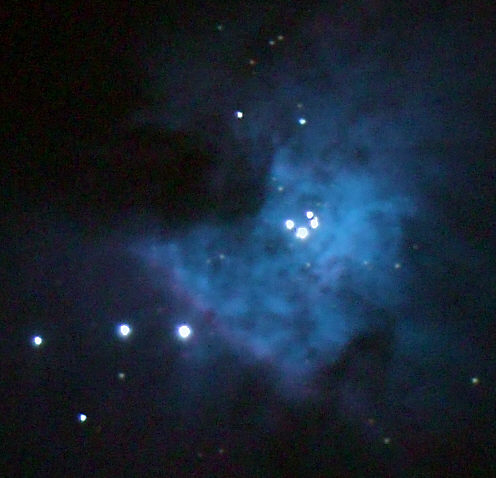
The E star is obvious and the F can also be detected by its tiny bulge on the periphery of the brightest star. Anyway, more recently I have upgraded to a C14 and here is a stack of 25x15sec exposures, basically to show how the tiny Trapezium in the middle relates to the binocular-visible larger nebula:
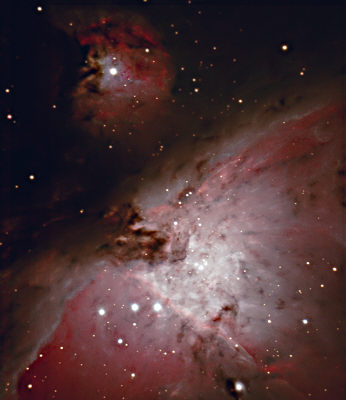
Notice the difference in the colour of the nebula backdrop. The 1Ds shows up the colours in the C8 image as humans would see them, blue (!), if our eyes' colour sensors were sensitive enough or the nebula were brighter (photopic vision). It is an unmodified camera capable of superb colour rendition in daytime photography. This camera is very insensitive to the deep red H-alpha line, just as the human eye is also very insensitive. The blue backdrop, I suspect, comes primarily from H-beta (blue) and OIII (teal). Red H-alpha gets more prominent on the peripheries of the nebula, according to wider views captured by the 1Ds, but the actual bright backdrop to the Trapezium is blue. The C14 image was taken with a modified Canon 20D. The camera is then sensitive to all wavelengths between 4000 and 10,000A, with very high sensitivity to red. Hence the deep red H-alpha overwhelms blue H-beta and teal OIII. Additionally, I wished to use the shortest possible exposures, so I did not filter out Infra Red. With this camera the IR brings with it some brownish tints. But for the ultimate in resolution, 15sec exposures are really too long with the mount I was using. The Canon 20D also has an annoying shutter shudder, even after mirror pre-release, that shows up in exposures of the order of one second. I had to examine a large number of shots to find a handful that were reasonably bright and had little shutter shudder. So below left is a stack of 5x4sec exposures using a C14, compared to an IR image from a seriously large, 8.2m (that's 323 aperture inches of actively deformable/adaptive mirror!) research telescope (the European Southern Observatory Very Large Telescope Antu, at Paranal, Chile), image taken by Mark McCaughrean, below right:
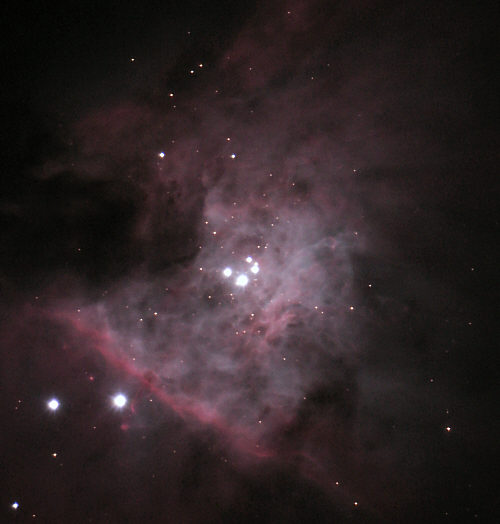
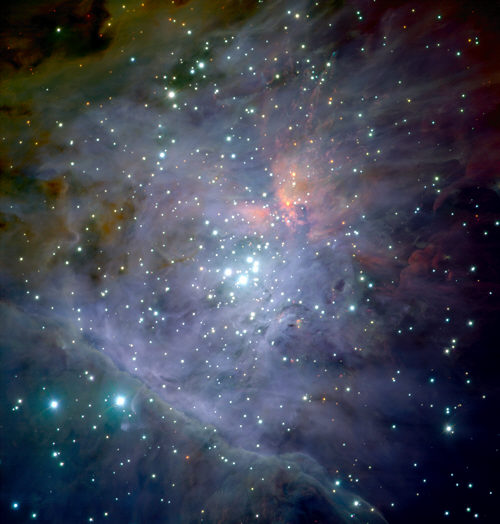
Points to note: the C14 seems quite competent in focusing both visible light and IR <10,000A, something I was unsure of from all that web chatter claiming that the glass corrector plate on SCTs would introduce chromatic aberrations. The ESO VLT image embraced wavelength bands centered around 12,400A, 16500A and 21,600A, much longer than my 10,000A cutoff, and hence is able to see stars otherwise obscured by the nebulosity. Stack depth was 13.5min for each tile in the mosaic. Indeed the Field of View of these large scopes is so narrow they need a 9-tile mosaic to cover such a small region. One day (OK, night!), with my new and more robust mount, I will attempt to go deeper than 20 seconds ;-) Below is a 200% enlarged crop of my 20sec stack, shot on 2nd Feb 2006, showing where to find stars A to I, compared to a couple of the most serious scopes on and off this planet, the above VLT Antu image and an HST image, both cropped from the highest resolution versions I could find on the web:
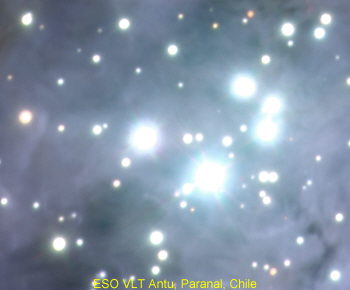
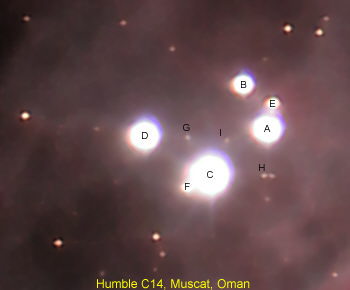
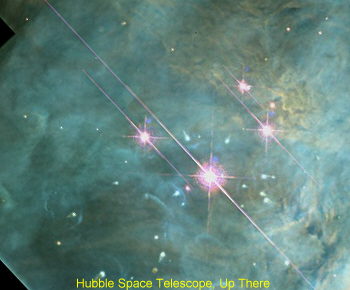

A, B, C, D are Magnitude 5 to 8 (C being the brightest, B the dimmest), E and F are at Mag 10, G, H and I at Mag 15. I am quoting the nomenclature and brightness data from Jerry Lodriguss. As for spacing, I tried to calibrate my image above against The Sky, and was astonished to find that the positions of most of the stars are highly erroneous in my version of that planetarium program. Luckily a DSLR frame is very large and I managed to calibrate on 14 very widely spaced, bright stars against The Sky to arrive at the above image scale. The reader may thus make his own measurements for any separation of interest. And, hey, all you double-star observers, how many claim to have seen H as a double? I measure a separation of (1.6+-0.1) arc-seconds from both the C14 and the HST versions. Considering that I centered on the stars of the doublet by eye on greatly enlarged versions of the above, but did not employ specialized software to find the centroids, an error estimate of half a pixel sounds reasonable. So there you have the lot: Trapezium A, B, C, D, E, F, G, H, I, and the pup of H :-)
Just as a postscript, Roland Christen, founder of AstroPhysics, is a very accomplished high resolution imager who seems to enjoy using hand-picked samples of his superb OTAs to show off what is possible with exquisitely hand-figured optics. Here is his Trapezium using an Astrophysics 10" f/14.6 Maksutov-Cassegrain, also a more recent attempt. I think my stock C14 acquits itself reasonably well, despite all the many remarks we come across disparaging the quality of mass-produced SCTs. In some cases size does matter ;-)
For more stuff return to Samir's Home
To drop me an e-mail just click on:
samirkharusi